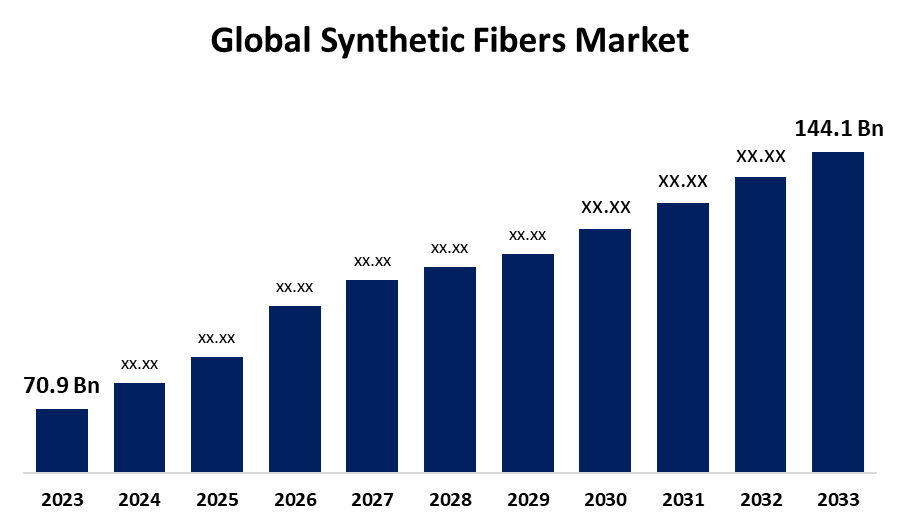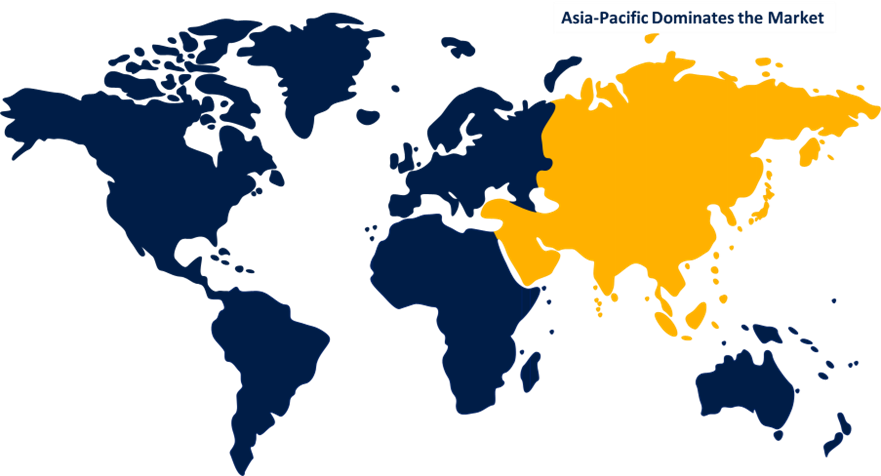Global Synthetic Fibers Market Size, Share, and COVID-19 Impact Analysis, By Type (Polyester, Nylon, Acrylics, Polyolefin, and Others), By Application (Clothing, Home Furnishing, Automotive, Filtration, and Others), and By Region (North America, Europe, Asia-Pacific, Latin America, Middle East, and Africa), Analysis and Forecast 2023 - 2033.
Industry: Chemicals & MaterialsGlobal Synthetic Fibers Market Insights Forecasts to 20233
- The Global Synthetic Fibers Market Size was Estimated at USD 70.9 Billion in 2023
- The Market Size is Expected to Grow at a CAGR of around 7.35% from 2023 to 2033
- The Worldwide Synthetic Fibers Market Size is Expected to Reach USD 144.1 Billion by 2033
- North America is expected to grow the fastest during the forecast period.

Get more details on this report -
The Global Synthetic Fibers Market Size is anticipated to exceed USD 144.1 billion by 2033, growing at a CAGR of 7.35% from 2023 to 2033.
Market Overview
Synthetic fibers market refers to the industry involving the production of synthetic fibers and fabrics. The fibers are chemical-based materials with many desirable properties including strength, softness, and elasticity, and are used in various applications such as apparel, construction, and automotive. The need for affordable, durable, and easy-to-clean materials is driving the demand for synthetic fibers in the textile industry. Because of their unique properties, synthetic fibers can be used in a variety of products, including sailcloths, helmets, armored vehicles, safety gear (such as police and military jackets), automotive fabrics, industrial fabrics, indoor and outdoor carpets, and home furnishings. There is a growing technological advancement along with an emphasis on sustainability, biodegradability, and smart textiles. The development of eco-friendly fibers, growing non-woven textiles, and the need for technical textiles are escalating the market growth opportunity for synthetic fibers.
Report Coverage
This research report categorizes the synthetic fibers market based on various segments and regions forecasts revenue growth and analyses trends in each submarket. The report analyses the key growth drivers, opportunities, and challenges influencing the synthetic fibers market. Recent market developments and competitive strategies such as expansion, type launch, development, partnership, merger, and acquisition have been included to draw the competitive landscape in the market. The report strategically identifies and profiles the key market players and analyses their core competencies in each sub-segment of the synthetic fibers market.
Global Synthetic Fibers Market Report Coverage
| Report Coverage | Details |
|---|---|
| Base Year: | 2023 |
| Market Size in 2023: | USD 70.9 billion |
| Forecast Period: | 2023 – 2033. |
| Forecast Period CAGR 2023 – 2033. : | 7.35% |
| 023 – 2033. Value Projection: | USD 144.1 |
| Historical Data for: | 2019-2022 |
| No. of Pages: | 210 |
| Tables, Charts & Figures: | 115 |
| Segments covered: | By Type, By Application and COVID-19 Impact Analysis |
| Companies covered:: | Bombay Dyeing, E. I. du Pont de Nemours and Company, Indorama Corporation, Lenzing AG, Mitsubishi Chemical Holdings Corporation, Reliance Industries Limited, China Petroleum Corporation (Sinopec Corp.), Teijin Limited, Toray Chemical Korea, Inc., Toyobo Co., Ltd., and Others Key Players |
| Pitfalls & Challenges: | Covid-19 Empact,Challenges,Growth, Analysis. |
Get more details on this report -
Driving Factors
The expanding use of synthetic fibers in the textile, industrial, indoor, outdoor, and commercial sectors, along with rising consumer demand for affordable, long-lasting, easy-to-clean materials are responsible for driving the market growth. The growing preference for synthetic fibers for various applications owing to their excellent chemical, mechanical, and physical properties is responsible for propelling the market. In addition, the rapidly evolving fashion trends and the demand for home furnishing due to the emergence of e-commerce platforms that facilitate quick product availability are anticipated to drive the market demand.
Restraining Factors
The environmental concerns regarding the production and disposal of synthetic fibers owing to its non-biodegradability properties are challenging the market. Further, the price fluctuations and competition from natural fibers may restrain the market growth.
Market Segmentation
The synthetic fibers market share is classified into type and application.
- The polyester segment dominated the market with the largest market share during the forecast period.
Based on the type, the synthetic fibers market is classified into polyester, nylon, acrylics, polyolefin, and others. Among these, the polyester segment dominated the market with the largest market share during the forecast period. The expanding application of polyester synthetic fibers in textile & apparel, automotive & transportation, home furnishing, industrial, and other applications are responsible for driving the market in the polyester segment.
- The clothing segment dominated the synthetic fibers market with the largest market share in 2023.
Based on the application, the synthetic fibers market is classified into clothing, home furnishing, automotive, filtration, and others. Among these, the clothing segment dominated the synthetic fibers market with the largest market share in 2023. Clothing made of synthetic fibers is long-lasting, wrinkle-resistant, and easily maintained. The shifting fashion trend affecting the need for garments is driving the market demand in the clothing segment.
Regional Segment Analysis of the synthetic fibers market
- North America (U.S., Canada, Mexico)
- Europe (Germany, France, U.K., Italy, Spain, Rest of Europe)
- Asia-Pacific (China, Japan, India, Rest of APAC)
- South America (Brazil and the Rest of South America)
- The Middle East and Africa (UAE, South Africa, Rest of MEA)
Asia Pacific is anticipated to hold the largest share of the synthetic fibers market over the predicted timeframe.

Get more details on this report -
Asia Pacific is anticipated to hold the largest share of the synthetic fibers market over the predicted timeframe. This is attributed to the large production of polyester, nylon, acrylics, and other materials by countries such as China, South Korea, Taiwan, India, and Japan. Further, the region's large population and high consumption of clothing and home furnishings are also expected to support market growth. In addition, the growing e-commerce platforms and customer awareness on clothing companies due to the Internet of Things contribute to propel the market growth.
North America is expected to grow at the fastest CAGR growth of the synthetic fibers market during the forecast period. Because of their affordability, adaptability, and durability, synthetic fibers are widely used in the textile industry to meet a variety of clothing needs, from performance sportswear to daily wear. The popularity of the ‘Made in US’ effort and the trend of purchasing apparel and home furnishing online are propelling the market growth in the region.
Competitive Analysis:
The report offers the appropriate analysis of the key organizations/companies involved within the synthetic fibers market along with a comparative evaluation primarily based on their type of offering, business overviews, geographic presence, enterprise strategies, segment market share, and SWOT analysis. The report also provides an elaborative analysis focusing on the current news and developments of the companies, which includes type development, innovations, joint ventures, partnerships, mergers & acquisitions, strategic alliances, and others. This allows for the evaluation of the overall competition within the market.
List of Key Companies
- Bombay Dyeing
- E. I. du Pont de Nemours and Company
- Indorama Corporation
- Lenzing AG
- Mitsubishi Chemical Holdings Corporation
- Reliance Industries Limited
- China Petroleum Corporation (Sinopec Corp.)
- Teijin Limited
- Toray Chemical Korea, Inc.
- Toyobo Co., Ltd.
- Others
Key Target Audience
- Market Players
- Investors
- End-users
- Government Authorities
- Consulting And Research Firm
- Venture capitalists
- Value-Added Resellers (VARs)
Recent Developments
- In February 2023, the International Organization for Standardization (ISO) released ISO 17256:2023, a new standard for synthetic fibers that have been recycled. This guideline would aid in ensuring the uniformity and quality of recycled synthetic fibers for the expanding market for sustainable textiles.
Market Segment
This study forecasts revenue at global, regional, and country levels from 2023 to 2033. Spherical Insights has segmented the synthetic fibers market based on the below-mentioned segments:
Global Synthetic Fibers Market, By Type
- Polyester
- Nylon
- Acrylics
- Polyolefin
- Others
Global Synthetic Fibers Market, By Application
- Clothing
- Home Furnishing
- Automotive
- Filtration
- Others
Global Synthetic Fibers Market, By Regional Analysis
- North America
- US
- Canada
- Mexico
- Europe
- Germany
- UK
- France
- Italy
- Spain
- Russia
- Rest of Europe
- Asia Pacific
- China
- Japan
- India
- South Korea
- Australia
- Rest of Asia Pacific
- South America
- Brazil
- Argentina
- Rest of South America
- Middle East & Africa
- UAE
- Saudi Arabia
- Qatar
- South Africa
- Rest of the Middle East & Africa
Frequently Asked Questions (FAQ)
-
1. What is the CAGR of the Synthetic Fibers market over the forecast period?The Synthetic Fibers market is projected to expand at a CAGR of 7.35% during the forecast period.
-
2. What is the market size of the Synthetic Fibers market?The Synthetic Fibers Market Size is Expected to Grow from USD 70.9 Billion in 2023 to USD 144.1 Billion by 2022, at a CAGR of 7.35% during the forecast period 2023-2033,
-
3. Which region holds the largest share of the synthetic fibers market?Asia Pacific is anticipated to hold the largest share of the synthetic fibers market over the predicted timeframe.
Need help to buy this report?